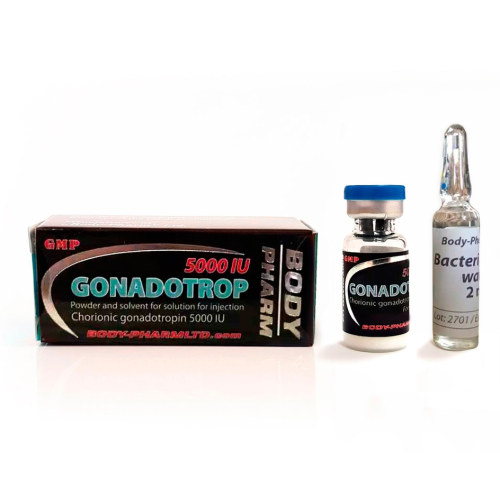BodyPharm Gonadotrop 5000IU
- Brand: Bodypharm
- Product Code: BodyPharm Gonadotrop 5000IU
- Availability: In Stock
-
$25.00
- Active substance: Human chorionic gonadothropine
- Manufacturer: Bodypharm
- Unit: 1vials (0.00) GonadotropinActive ingredient: Human Chorionic GonadotropinAlternate names: HCG, Gonado, Ovidrel, Pregnyl, PubergenActive half-life64 hours
Human Chorionic Gonadotropin (HCG) is a potent polypeptide hormone present in pregnant women and commonly utilized in therapeutic contexts for conditions like cryptorchidism, female infertility, hypogonadism (low testosterone), and weight loss.
HCG is also frequently employed by users of anabolic steroids as a supplementary agent during or after a steroid cycle. During steroid use, its purpose is to alleviate hormonal suppression caused by the steroids. Post-cycle, it aids in enhancing recovery and restoring natural hormone levels.
Effects of Gonadotropin:
One of the core uses of HCG in contemporary practice is as a dietary aid. The HCG diet has gained significant traction in Western medicine, although its efficacy remains a contentious topic. Both the American Medical Association and the American Society of Bariatric Physicians have criticized the HCG diet, asserting that weight loss is primarily due to the severe caloric restriction typically involved (often around 500 calories per day). Furthermore, HCG does not stimulate the thyroid, nor does it act as a beta-2 stimulant, control appetite, or exhibit any thermogenic or fat-burning properties. Despite reports of success from various physicians using the HCG diet, critics note that its weight loss effects cannot be conclusively attributed to HCG, especially since caloric restriction alone accounts for the results. The debate surrounding this diet is likely to persist for years to come.
For anabolic steroid users, HCG's effects can be categorized into two main areas: post-cycle therapy (PCT) and use during a cycle. Anabolic steroid use typically suppresses natural testosterone production. The degree of suppression varies based on the specific steroids and dosages involved, but is generally significant. After steroid use, testosterone levels will gradually recover on their own, barring any pre-existing conditions or severe disruption to the HPTA (hypothalamus-pituitary-testicular axis) from prior steroid use. This natural recovery is often slow and can lead to low testosterone symptoms which may hinder muscle retention as cortisol levels rise in the absence of testosterone. To facilitate recovery, many steroid users adopt a PCT regimen, though this will not fully restore normal testosterone levels on its own, it ensures that adequate testosterone is available for proper bodily functions during the recovery process.
PCT strategies typically include the use of Selective Estrogen Receptor Modulators (SERMs) such as Nolvadex (Tamoxifen Citrate) or Clomid (Clomiphene Citrate). Some users find that initiating a PCT plan with HCG prior to introducing SERMs improves the overall recovery experience. Essentially, HCG mimics luteinizing hormone (LH) and prepares the body for subsequent SERM therapy, leading to a more effective recovery.
The second benefit of HCG for anabolic steroid users comes from its use during a steroid cycle. Steroid use often leads to testicular atrophy due to suppressed natural testosterone levels. Supplementing with HCG during this time can help maintain testicular size. While this is mainly a cosmetic concern, it may facilitate a smoother recovery process once steroid use ceases. However, there is a risk of the body becoming dependent on HCG for LH needs, which can be problematic. This dependency isn’t a concern for individuals with low testosterone levels using HCG, but for non-low testosterone users, HCG should be closely monitored to prevent dependency. Many anabolic steroid users have inadvertently caused more harm through excessive HCG use than through steroid use itself. Responsible use of HCG can be beneficial for easing into recovery, but it must be managed carefully in both scenarios—during cycles and as part of PCT.
HCG can serve various purposes, leading to multiple dosing protocols. For ovarian stimulation (fertility support), HCG is usually administered at a specific time during the menstrual cycle, at doses ranging from 5,000 to 10,000 IU. For treating low testosterone, HCG therapy may last from 6 weeks to a year. Short-term regimens typically involve 500-1,000 IU three times a week for three weeks, followed by 500-1,000 IU twice a week for another three weeks. Long-term use often consists of approximately 4,000 IU three times a week for 6-9 months, followed by an additional three months at 2,000 IU three times a week.
For anabolic steroid users, the standard dose of HCG during a cycle is about 250 IU every 4-5 days, which is sufficient to achieve desired results without risking future natural testosterone production.
Regarding PCT use, there are two main protocols. The first option is to administer 1,500-4,000 IU every 3-4 days for 2-3 weeks, after which SERM therapy begins. The second, potentially more effective method, involves daily administration of 500-1,000 IU for ten consecutive days, followed by SERM therapy.
Timing of HCG administration is crucial if it’s part of your PCT. If finishing a steroid cycle involving large esters, HCG therapy should begin 10 days after the final injection, transitioning to SERM therapy afterward. Conversely, if concluding with small esters, HCG therapy starts 3 days post-injection, followed by SERM therapy thereafter.

